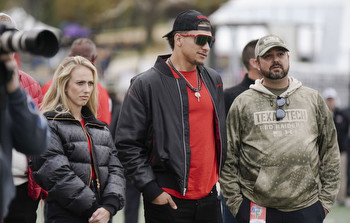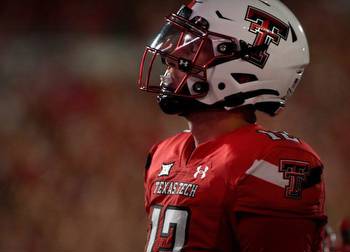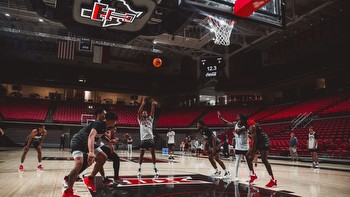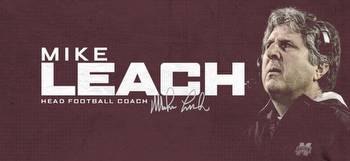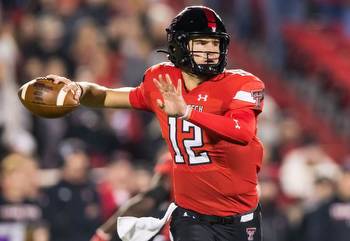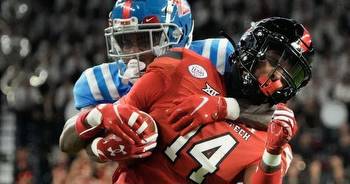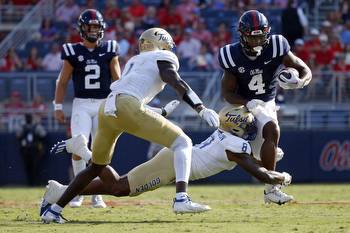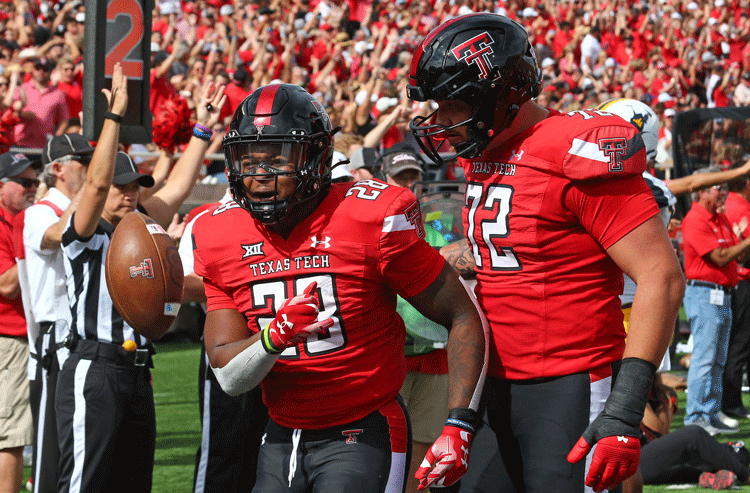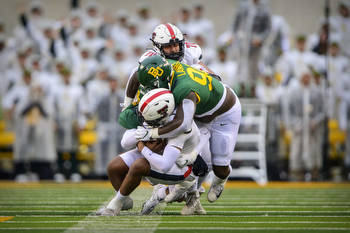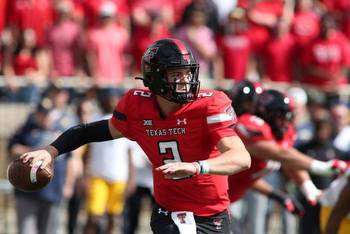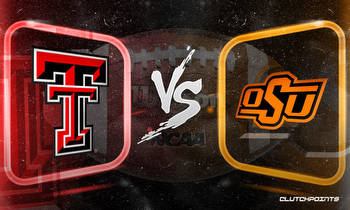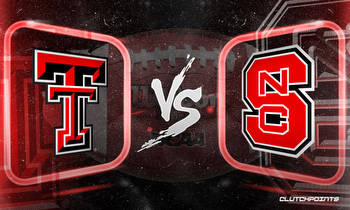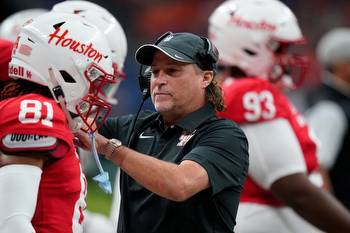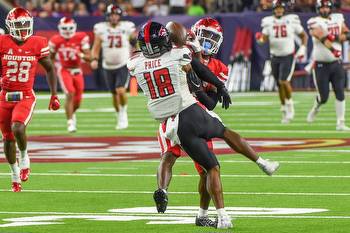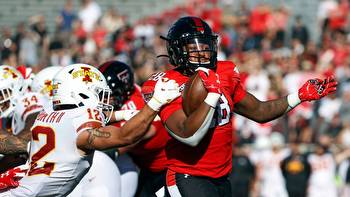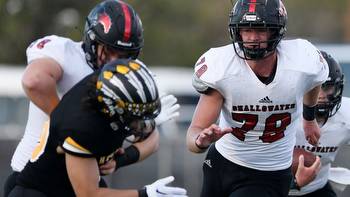Can big oil money turn Texas Tech into college football’s next powerhouse?

LUBBOCK, Texas — A pair of flat-top cranes loom high above Jones AT&T Stadium, home of the Texas Tech Red Raiders. Head football coach Joey McGuire is sporting a hard hat, safety glasses and reflective vest, bracing himself to make good on a friendly social-media pledge: 3,000 retweets, and he’d climb one of these suckers.
Straight up, 220 feet into the air, McGuire’s breath shortens and chest tightens with each rung. When he finally hits the top, he exhales in equal parts relief and terror. Then he peeks over the edge, hand clasped to the railing, to catch a sky-scraping glimpse of the kingdom he stands to inherit. Beneath his feet is $230 million worth of planned construction, part of a massive, ongoing facilities project that will renovate the stadium’s south end zone and add a brand-new football training facility.
That’s a striking investment for any athletics department, including Texas Tech, a proud program but not one of college football’s elites. McGuire’s presence, on the sideline or hundreds of feet above it, has been crucial to turning the project into reality, injecting considerable excitement into the program with an encouraging 8-5 record in 2022.
Another reason — arguably the most significant — lies a few hours south of the stadium, hidden just beneath the surface: oil.
Oil money is not a novel source of big-money boosterism in college sports. T. Boone Pickens famously pumped barrels into Oklahoma State University athletics. But while the transfer portal and name, image and likeness legislation are remodeling college football’s financial and competitive structure, Tech’s windfall is funding both the old-school facilities arms race and new-school NIL marketplace, part of a broader alignment among deep-pocketed supporters and the administration.
“I always tell people, oil money is real,” McGuire says. “I knew the backing was here (when I took the job). But quite honestly, I didn’t dream of what it would be.”
Lubbock sits 300-plus miles from the closest metropolis in any direction, an island landlocked by vast, open prairies of red dirt and farmland. But at the heart of the city is Texas Tech’s bustling campus brimming with Spanish Renaissance architecture and roughly 40,000 students.
“Any restaurant or place you go into, it’s red and black and for the Double T,” McGuire says.
That Red Raider fandom extends as far as the mesquite-lined towns of Midland and Odessa, part of a West Texas region dubbed the Permian Basin, the largest oil-producing field in America. Production peaked in the 1970s before ramping back up in recent decades thanks to the “Shale Revolution,” spurred by advancements in hydraulic fracturing (also known as fracking) and horizontal drilling into underground shale rock.
“We are the university of the Permian Basin, essentially, and that has really helped in terms of our fundraising capacity,” says booster Cody Campbell. “We have a lot of people who are capable of giving.”
Campbell is one of them. He co-founded Double Eagle Energy Holdings in 2008 with childhood friend John Sellers, and the two West Texans played football at Texas Tech for legendary coach Mike Leach. After Campbell’s brief NFL career with the Indianapolis Colts, he and Sellers were working in real estate when the financial crisis led them to the oil and gas industry. They leaned on their real estate backgrounds and Texas roots to establish an upstream company in the Permian Basin, leasing land to build out drilling operations and then selling those builds to other energy companies. It’s the oil-rush version of house flipping — think “There Will Be Blood” meets “Fixer Upper.”
In 2017, Double Eagle sold a development for $2.8 billion. In 2021, it sold another for $6.4 billion.
Campbell, 41, looks more the part of retired athlete than wealthy oil magnate, the broad-shouldered wingspan on his 6-foot-4 frame still imposing enough to stymie a pass rush, cowboy boots and all. But in December 2021, the former Red Raiders offensive guard made his most significant contribution in the form of a $25 million donation for Texas Tech’s south end zone project, including the naming rights to Cody Campbell Field at Jones AT&T Stadium.
“It is a manifestation and representation of our ambitions, and that’s what I’m proud of,” Campbell says. “Texas Tech is West Texas, and I love West Texas, love the people. Tech needs to be great in order for West Texas to be great, and that’s what I work on every day.”
Tech’s list of mega-donors isn’t exclusive to oil magnates: Dustin Womble, whose name will be on the new football training facility and already adorns the basketball facility, made his fortune in software. But the region’s oil-dipped rejuvenation has elicited a more extensive and wealthier donor base.
“The resources we enjoy from the Permian Basin and the people who work there is incredible,” says athletic director Kirby Hocutt. “I’m one of the few ADs in the country who is OK with fuel being $5 a gallon.”
According to Hocutt, Texas Tech has raised more than $100 million for what will be the largest contiguous football facility in the country, bolstered by the lead gifts from Womble ($20 million) and Campbell, both of whom are also on the university’s board of regents.
But this is the brave new world of college football, meaning that new-school oil money also fuels the Matador Club, a non-profit NIL collective spearheaded by Campbell and Sellers that supports Red Raiders athletes and operates under the auspices of Double Eagle. It has an annual NIL budget of $8 million spread across all Tech athletics, including 120 football players — scholarship and non-scholarship — receiving at least $25,000 a year.
The broader landscape of college football may be in turmoil following another wave of realignment, but the horizons remain clear in Lubbock. With the College Football Playoff set to expand to 12 teams and the Big 12 Conference finally stabilized despite Texas and Oklahoma departing for the SEC, the Red Raiders see an opportunity: to seize control of a new-look Big 12 and become a relevant program in the national conversation.
“This administration is serious about winning, and we’re doing everything we can to get behind that mission,” McGuire says. “We have an opportunity. Let’s not let it pass us by. Why not Texas Tech?”
McGuire did his research.
He was an assistant coach at Baylor when Texas Tech fired Matt Wells in October 2021, eight games into his third season with a 13-17 overall record. A lifelong Texas resident and former state champion high school coach, McGuire had never even been a college coordinator. Still, he asked his agent to track down phone numbers for Hocutt, Campbell and Womble.
“I just looked at Tech as a sleeping giant,” McGuire says. “I really wanted this job, and I wanted to make sure I did everything I could to get in front of them. For a Texan and a guy like me, it was a perfect fit.”
Tech has a reputation for making outside-the-box hires, but it couldn’t afford to get this decision wrong. The history of Texas Tech football is one of almost, a plucky underdog perpetually in the shadow of more prominent in-state programs like Texas and Texas A&M.
There were pockets of success in the old Southwest Conference, but Leach made the biggest splash in the aughts, after the program joined the Big 12. An esoteric Air Raid disciple, Leach went 84-43 over 10 seasons while revolutionizing college offenses. But he was fired in December 2009 after an investigation into the treatment of receiver Adam James, the son of former NFL running back and ESPN analyst Craig James, after the player was diagnosed with a concussion. Multiple lawsuits and public acrimony between the coach and university followed the controversy, leaving a fractured fan base in its wake.
“There was a division,” says Hocutt, who took over as athletic director in 2011. “It’s so hard to win in college football. You must have alignment and momentum, that energy behind your program. That was strained here.”
Tech, which has never played in a Big 12 Championship Game, has yet to recapture the heights and consistency of the Leach era, cresting with a last-second upset of the top-ranked Longhorns in 2008. Instead, the program endured a string of failed hires: Tommy Tuberville, Kliff Kingsbury and Wells, with more losing records (seven) than bowl appearances (six) in 12 seasons. Even three years of Patrick Mahomes at quarterback couldn’t salvage things.
Campbell — a two-year starter who played from 2000-04 — coped with the downturn like many fans do: by posting on message boards. As a former player and rising booster, Campbell’s perspective held weight with the fan base.
“Cody didn’t really hide who he was. I think his username was his first and last name with his jersey number,” says Chris Level, publisher of the Rivals site RedRaiderSports.com and longtime radio host for Texas Tech programming. “He’s a guy who played in this program and is very passionate about it. He just happened to be worth a lot more than most people.”
Wells’ tenure was a tipping point for Campbell. The former Utah State coach was a curious hire ahead of the 2019 season, with no history in Texas to speak of. Campbell initially offered his support — partly to appease Hocutt — but it was short-lived. As the team struggled early on, a casual midweek visit between Campbell and Wells turned contentious, according to Campbell, and Campbell told Wells he didn’t like the direction the program was headed. (Wells, now an analyst on Oklahoma coach Brent Venables’ staff, declined through a spokesperson to comment for this story.)
“He didn’t appreciate it, and that’s fine — I understand boosters shouldn’t be running the program,” says Campbell. “But I invest in this thing. … I know it’s a great place, and I know we can win here.”
Campbell signaled those feelings publicly, which caused a rift with Hocutt. The two didn’t speak until Campbell was appointed to the board of regents in April 2021. Once Campbell made clear his goal was to work with Hocutt — and that he would tone it down on the message boards — they realized how closely their visions aligned.
“I’ve been doing this long enough to know not to take things personally,” Hocutt says. “The thing I’ve always respected about Cody Campbell is that he wants Texas Tech to be successful and win. And we’ve always shared that passion.”
Hocutt fired Wells on Oct. 25, 2021. While some outsiders were jolted considering the team’s 5-3 start, the local disconnect between Wells and the fan base was simmering, underscoring how desperately Tech needed to stick the landing on its next hire.
Hocutt appointed Campbell and Womble (who joined the board of regents in 2019) to the search committee. The group was familiar with McGuire’s strong recruiting ties throughout the state, but his lack of college experience bumped him down their initial candidate list. Until they talked to him.
“The energy, enthusiasm and desire to be here. In a short amount of time, he convinced me that Texas Tech was the only place in the world he wanted to coach,” Hocutt says. “What Joey has brought to not just our university, but our entire community, you cannot put a dollar value on. He’s special.”
McGuire quickly turned an ostensibly risky hire into an inspired one — a recent season-opening, double-overtime upset loss to Wyoming notwithstanding. Beyond Year 1 wins over Texas and Oklahoma in the same season for the first time in program history, McGuire has been the antidote to much of what ailed Tech since Leach’s dismissal. He embraced Lubbock and the surrounding areas, from the students chasing shots at Chimy’s to the old-timers eating chopped brisket at Tom & Bingo’s. He rarely declines an invitation to an event or speaking engagement and is known to arrive early and stay late. He propped open the door to welcome back former players. He’s the uniter and missing link for a donor pool desperate to invest in something it believes in.
“Joey has been a breath of fresh air,” says Gary Petersen, another prominent Tech booster in the oil and gas industry. “When he came in, the whole mood changed. Everybody is in love with him.”
That attitude — and a McGuire-sparked boost on the recruiting trail — has fueled the renewed hope for an eventual breakthrough for Red Raider football. But nearly as critical was mending any lingering Leach divide. McGuire has celebrated the former head coach, who died in December, even sporting a jacket with a custom-designed pirate lining at Big 12 media days. The university has also worked to heal those wounds: Leach will be posthumously inducted into the Texas Tech Hall of Honor next month. All of the litigation regarding Leach’s dismissal from the university has been settled or dropped, and his widow, Sharon, has committed to attend the induction ceremony.
“If you go back to the Leach days, we were so cohesive and aligned about what Texas Tech football was. We had an identity our fan base could sink its teeth into,” Womble says. “Joey has brought that back again.”
The forthcoming Womble Football Center will include two floors of state-of-the-art training and meeting spaces, connected via sky bridge to a four-story end-zone structure housing luxury suites, coaches offices and a 7,200-square-foot field-level club, scheduled to be completed before the 2024 season. The south end zone will be blocked off during home games this fall, starting with a marquee, non-conference showdown this Saturday against No. 13 Oregon — oil money vs. sneaker money.
The most important feature, however, will be a familiar one: the iconic Double-T scoreboard. The original, which hovered over the south end zone for 44 years, will be repurposed as a local landmark and replaced by a newly constructed replica at The Jones — a tidy encapsulation of the university’s efforts to honor its history while championing its ambitions.
That responsibility falls mainly to the Red Raider Facilities Foundation, a 501(c)3 formed to oversee the project. The university ground-leased the stadium and surrounding area to the foundation, allowing for the expedited construction timeline of a private-sector job.
“Kirby was super open, creative and forward-leaning on this. He didn’t get stuck on the way things were always done,” Campbell says. “He’s been the same way on a number of initiatives.”
NIL is another. While some schools tried to hold the name, image and likeness bear at bay — or ceded too much leeway to impulsive outside influences — Campbell and Sellers manage the Matador Club with the same tact as Double Eagle’s multi-billion-dollar builds.
The program has largely avoided being poached through the transfer portal and retained several players who could have entered the NFL Draft, including Tyree Wilson, who returned for the 2022 season and developed into a top-10 pick. And although the Matador Club earmarks roughly half of its $8 million annual budget for football and those $25,000 base-rate minimums, the goal is to sign every athlete on campus to an NIL deal, which it has achieved for men’s and women’s basketball, softball, baseball, track and golf.
“I thought if we organized and ran this thing like a business, that we could gain an advantage,” Campbell says. “We’re not promising recruits anything. We want kids who want to be at Texas Tech, and once they’re here, we take care of them.”
NIL money doesn’t guarantee victory — evidenced by last weekend’s loss to Wyoming — and palatial locker rooms and good vibes don’t win conference championships or secure Playoff berths. One only needs to look 400 miles southeast to Austin, where the burnt-orange coffers are constantly overflowing with little to show for it lately. But in West Texas, optimism is as abundant as the petroleum beneath its soil.
It was palpable at field level of Jones AT&T Stadium, as a hard-hatted Hocutt admired the headway and envisioned the not-so-distant future.
“This south end zone will change what is already a great home-field advantage,” he says. “It’s going to be imposing.”
Then he glanced across a fresh batch of turf and let his mind wander a bit further.
“I turned around and was already thinking about what we can do with the north end zone, ya know?” says Hocutt. “What’s next?”
(Illustration: Eamonn Dalton / The Athletic; photos: Courtesy of Texas Tech Athletics)
